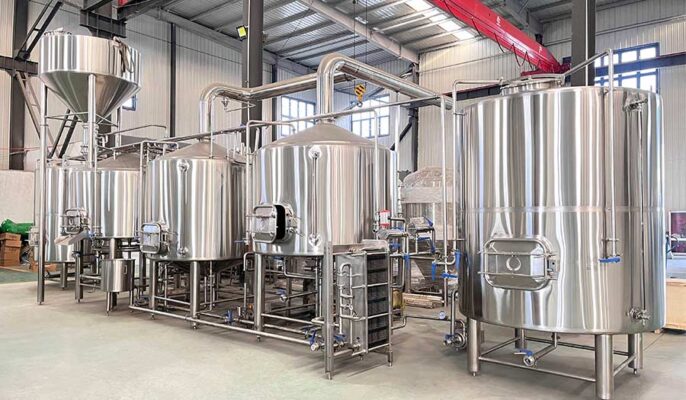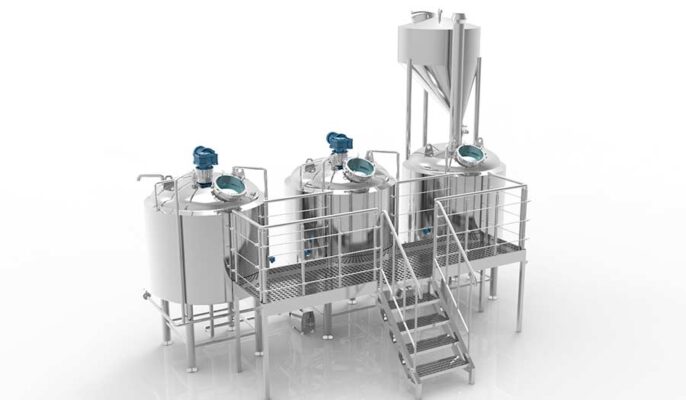醸造業界では、3容器醸造システムは効率的で柔軟な醸造ソリューションとして、多くの醸造所や醸造業者にとって最初の選択肢となっている。このシステムは、麦汁樽、ローター・タン、ケトルという3つの主要コンポーネントで構成されている。各容器は醸造プロセスにおいて特定の役割を果たし、醸造プロセスをよりよくコントロールし、より安定した最終製品を生産することができる。
3容器醸造システムとは何ですか?
3容器醸造システムは通常、マッシングタンク、ロータリングタンク、ボイリングケトルの3つの主要コンポーネントで構成されています。3容器醸造システムのワークフローは、原料の仕込みから始まり、もろみ、ろ過、煮沸といった複数の工程を経て麦芽をアルコール飲料へと変化させる。各容器の役割と設計は非常に重要であり、それらが一体となって醸造プロセスの効率と安定性を保証します。3容器醸造システムは、プロのホームブルワーにとって究極の設備です。3つの独立した釜で構成され、それぞれが醸造プロセスで重要な役割を果たします。
マッシング・タンク
- 機能粉砕した麦芽を湯と混ぜ、加熱・攪拌しながらデンプンを糖に変える。
- プロセスもろみ中の酵素がでんぷんを分解し、発酵可能な糖を生成する。この工程の温度と時間をコントロールすることが、最終製品の風味と品質を左右する。
ラウタリングタンク
- 機能液体麦汁と固体残渣を分離する。
- プロセスマッシュ後、麦汁はフィルターケトルで分離する必要がある。固形残渣はフィルターケトルの底に残り、透明な麦汁はボイラーに流れてさらに処理される。
沸騰ケトル
- 機能:麦汁を煮沸し、ホップを加えて最終的な風味を調整する。
- 工程:ボイラーで麦汁を沸点まで加熱し、ホップを加えてビールの苦味と香りを引き立てる。また、沸騰させることで液体から不要な成分を取り除き、クリアなビールに仕上げます。

3器の種類 醸造設備システム
- 自家製醸造機器:趣味で自家醸造を行う人向けの製品。よりコンパクトで、ガレージや専用の醸造室に簡単に収めることができる。自家醸造は、多くのビール愛好家にとって素晴らしい出発点であり、自宅で快適に少量のビールを醸造する実践的で創造的な方法を提供する。
- ナノ醸造システム:自家醸造と商業醸造の架け橋となるナノ・ブルーイング・システムは、容量が大きいが、カフェや実験的な醸造ラボのような小さなスペースに適している。これらのシステムは通常、半自動化されており、より頻繁な醸造に適している。
- 地ビール設備:小規模醸造所またはクラフトビール醸造所は、自家醸造所よりは大きいが、商業醸造所よりはまだ小さい。高度に自動化されており、発酵タンクなどの容器を追加することができる。
- 業務用醸造所システム:これらのシステムは大規模生産用に設計されており、大量のビールを生産する実績のある醸造所で使用されています。
- 完全に自動化され、高度な監視システムを備え、通常は醸造所のニーズに合わせてカスタマイズすることができる。商業醸造所は大規模で、より広い市場にビールを供給している。
3ベッセル・ブリューイング・システム 機器の機能
3ベッセル・ブリューイング・システムは、業務用または家庭用の醸造に使用される装置で、その主な機能は、麦芽、麦汁、ホップなどの原料をビールに変えることである。
マッシング・ポット
- Wort Tub Starch Conversion: The wort tub is where the ground grains meet the hot water. This interaction activates enzymes in the malt, which convert the grains’ starches into fermentable sugars. This sweet liquid is called wort and is the basis of beer.
- 温度ステップ:醸造レシピによっては、マッシングの段階ごとに異なる酵素を活性化させるために異なる温度を必要とします。最近の麦汁桶には、多段階のマッシングを可能にする高度な温度制御が装備されている。
フィルタータンク
- 麦汁と穀物の分離マッシングが終わったら、麦汁をグレーンベッドから分離する必要がある。フィルタータンクの底には溝があり、麦汁を通過させ、穀物床は固形に保ちます。
- すすぎ:穀物床に残った糖分を抽出するため、温水で穀物床を洗い流す工程。フィルタータンクは、温水を穀物床に均等に行き渡らせることで、すすぎを容易にする。
沸騰ケトル
- 沸騰させ、ホップを加える:集めた麦汁を煮沸釜に入れて煮沸する。ホップは煮沸のさまざまな段階で加えられ、ビールに苦味、風味、香りを加える。
- 殺菌:麦汁の煮沸にはもうひとつ重要な役割がある。沸騰させる過程で有害な微生物はすべて破壊され、その後の発酵を清潔に保つことができる。
- 渦の形成:沸騰釜の中には、液体が循環して渦を形成するワールプール機能を持つものがあります。これにより、固形粒子を中央に沈殿させ、側面から透明な麦汁を引き出しやすくする。

3容器醸造システムの価格は?
The cost of a three-vessel brewing system can vary greatly depending on several factors. These factors include the system’s capacity, materials, level of automation, brand, and additional features. Whether you are a home brewer or a commercial brewer, understanding the cost structure is critical to making an informed decision.
|
システム容量 |
価格帯 |
|
5ガロン |
$500 - $1,500 |
|
10ガロン |
$1,500 - $3,500 |
|
1BBL(31ガロン) |
$5,000 – $10,000 |
|
5BBL(155ガロン) |
$20,000 - $40,000 |
|
10BBL(310ガロン) |
$40,000 – $80,000 |
- サイズ/容量:三槽式醸造システムには、数ガロンの小さな自家製セットアップから、数千ガロンを自然に生産できる大規模な業務用システムまである。
- 材質ステンレス・スチールは、耐久性、耐食性、清掃のしやすさから、最も一般的に使用されている素材である。ただし、ステンレスの品質や厚みはさまざまで、価格に影響することもある。
- 自動化:電子制御、ポンプ、電動バルブを含む自動化システムは、手動システムよりも高価である。しかし、より高い精度と使いやすさを提供する。
- 追加機能:システムによっては、一体型熱交換器、高度な温度制御、さらには穀物粉砕機などの追加機能が付いているものもある。これらの機能はそれぞれ、コストを増加させる可能性がある。
- 設置とトレーニング:多くのメーカーは、設置サービスやトレーニングコースを提供している。これは初期投資額を増やすかもしれないが、システムが正しくセットアップされ、あなたやあなたのチームが効果的に操作する方法を知っていることを保証する。
3容器醸造設備の選び方
- 醸造目標を明確にする:醸造するビールの量を考えてください。自家醸造では通常20~200Lを選びますが、商業醸造所ではより大きなシステム・サイズを必要とします。
- 素材の選択:高品質の3ベッセルシステムのほとんどは、耐食性、耐熱性、洗浄性に優れたステンレスを使用している。エントリー・レベルのシステムには、アルミやその他の素材を使用したものもあり、安価ではあるがステンレスほど耐久性が高くない場合もある。
- スペースへの配慮:サイズとスペースは非常に重要です。醸造スペースを測定し、収容できる最大システムサイズを決定します。移動、保管、その他の醸造用アクセサリーのための追加スペースを考慮することも忘れずに。
- カスタマイズ・オプション:カスタマイズ・オプションを提供しているメーカーもある。追加のセンサー用のポートを追加したり、システムの外観をパーソナライズしたりと、これらのオプションによって、醸造システムを本当にユニークなものにすることができる。
- メンテナンス定期的なメンテナンスは、醸造システムの寿命と性能に欠かせません。洗浄やメンテナンスが簡単なシステムを選びましょう。
- 保証とサポート:メーカーが提供する保証とアフターサポートを考慮する。保証がしっかりしていれば、メーカーが製品に自信を持っていることがわかりますし、サポートがしっかりしていれば、問題が発生したときに確実に助けてもらえます。
- サプライヤーの評判:サプライヤーの評判には特に注意を払う。他の醸造者は、関連する問題についての洞察を提供してくれる。
よくあるご質問
3容器醸造システムとは何ですか?
3ベッセル・ブリューイング・システムとは、ビール醸造に使用される設備の一種で、3つの主要な容器を含む:マッシング・ケトル(Mashing Kettle)、ローダー・タン(Lauder Tun)、ボイル・ケトル(Boil Kettle)。各容器の機能は、マッシング、フィルタリング、沸騰です。
3容器醸造システムの価格帯は?
具体的な価格は醸造のニーズによって異なるが、おおよその目安は以下の通り:
- エントリーレベル・システム:$300~$800
- ミッドレンジ・システム:$800~$2,000
- ハイエンドシステム:$2,000~$5,000以上
3ベッセル・ブリューイング・システムとシングルポット・システムの違いは何ですか?
3ベッセルシステムは、マッシング、フィルターリング、ボイリングのための3つの専用ベッセルがあり、コントロールの精度が高く、効率が良い。シングルポットシステム(シングルポットマッシングシステムなど)は、これらのステップを1つのポットに集中させるもので、操作は簡単ですが、3ベッセルシステムほど効率的でコントロールしやすいとは限りません。
冷却装置を取り付ける必要がありますか?
そう、冷却装置(冷却コイルやスプレークーラーなど)は、煮沸した麦汁を発酵に必要な温度まで素早く冷却し、細菌汚染や過熱を避けるために非常に重要である。




